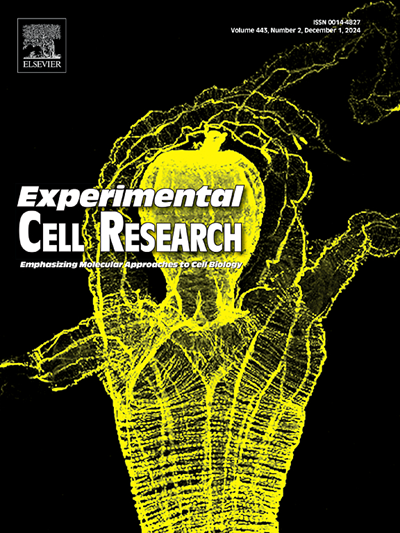下调 CTRP1 可抑制 CD133 在 X 射线和碳离子照射后的表达,从而降低胶质母细胞瘤细胞的放射抗性
IF 3.3
3区 生物学
Q3 CELL BIOLOGY
引用次数: 0
摘要
胶质母细胞瘤(GBMs)是最常见的原发性恶性脑肿瘤,由于其侵袭性、高复发率和有限的治疗方案,给治疗带来了巨大挑战。放疗是治疗脑胶质瘤的基石,然而,耐药性是治疗的一大障碍。本研究利用X射线和碳离子照射,研究了脂肪因子C1q/TNF相关蛋白1(CTRP1)在GBMs放射敏感性中的作用。表达分析表明,GBMs 组织中的 CTRP1 和 CD133 水平升高与患者存活率低有关。与 X 射线相比,碳离子照射对生长的抑制作用更强,尤其是对 U87(高 CD133)细胞。此外,CTRP1的表达在辐照后增加,尤其是在X射线治疗后。通过减少细胞增殖和增加细胞凋亡,同时加剧氧化应激,敲除 CTRP1 增强了放射敏感性。生物信息学分析表明,CTRP1参与了DNA损伤修复途径。我们的研究结果在 CTRP1 与细胞放射敏感性之间建立了一种新的联系。靶向 CTRP1,尤其是 U87(高 CD133)细胞,可增强 GBM 的放射敏感性,从而提供潜在的治疗途径。本文章由计算机程序翻译,如有差异,请以英文原文为准。

Downregulation of CTRP1 reduces radio-resistance in glioblastoma cells by inhibiting the expression of CD133 after X-ray and carbon ion irradiation
Glioblastomas (GBMs), the most prevalent primary malignant brain tumors, present significant challenges due to their invasive nature, high recurrence rates, and limited treatment options. Radiotherapy is a cornerstone in the management of GBMs; however, resistance to treatment poses a substantial obstacle. This study investigates the role of adipokine C1q/TNF-related protein 1 (CTRP1) in the radio-sensitivity of GBMs, utilizing both X-ray and carbon ion irradiation. Expression analyses revealed elevated CTRP1 and CD133 levels in GBMs tissues, which were associated with poor patient survival. Carbon ion irradiation demonstrated superior growth inhibition compared to X-ray, particularly in U87 (high CD133) cells. Moreover, CTRP1 expression increased following radiation exposure, especially after X-ray treatment. Knockdown of CTRP1 enhanced radio-sensitivity by reducing cell proliferation and increasing apoptosis, while exacerbating oxidative stress. Bioinformatics analysis revealed CTRP1's involvement in DNA damage repair pathways. Our findings establish a novel connection between CTRP1 and cellular radio-sensitivity. Targeting CTRP1, especially in U87 (high CD133) cells, enhances GBMs radio-sensitivity, offering potential therapeutic avenues.
求助全文
通过发布文献求助,成功后即可免费获取论文全文。
去求助
来源期刊

Experimental cell research
医学-细胞生物学
CiteScore
7.20
自引率
0.00%
发文量
295
审稿时长
30 days
期刊介绍:
Our scope includes but is not limited to areas such as: Chromosome biology; Chromatin and epigenetics; DNA repair; Gene regulation; Nuclear import-export; RNA processing; Non-coding RNAs; Organelle biology; The cytoskeleton; Intracellular trafficking; Cell-cell and cell-matrix interactions; Cell motility and migration; Cell proliferation; Cellular differentiation; Signal transduction; Programmed cell death.
 求助内容:
求助内容: 应助结果提醒方式:
应助结果提醒方式:


